2022 TOYOTA COROLLA glove box
[x] Cancel search: glove boxPage 125 of 678
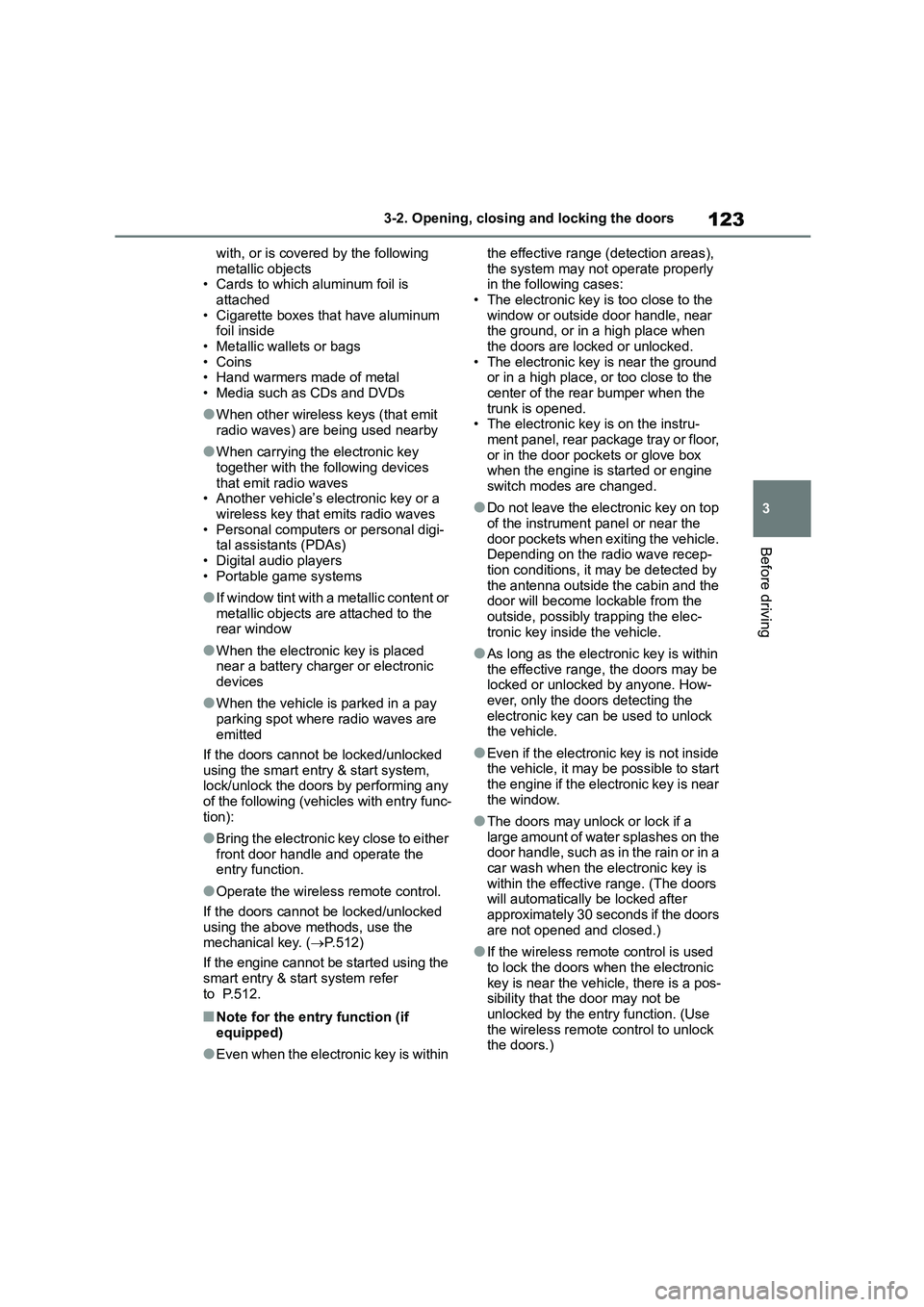
123
3
3-2. Opening, closing and locking the doors
Before driving
with, or is covered by the following
metallic objects • Cards to which aluminum foil is
attached
• Cigarette boxes that have aluminum foil inside
• Metallic wallets or bags
•Coins • Hand warmers made of metal
• Media such as CDs and DVDs
●When other wireless keys (that emit
radio waves) are being used nearby
●When carrying the electronic key
together with the following devices
that emit radio waves • Another vehicle’s electronic key or a
wireless key that emits radio waves
• Personal computers or personal digi- tal assistants (PDAs)
• Digital audio players
• Portable game systems
●If window tint with a metallic content or
metallic objects are attached to the rear window
●When the electronic key is placed near a battery charger or electronic
devices
●When the vehicle is parked in a pay
parking spot where radio waves are
emitted
If the doors cannot be locked/unlocked
using the smart en try & start system,
lock/unlock the doors by performing any of the following (vehicles with entry func-
tion):
●Bring the electronic key close to either
front door handle and operate the
entry function.
●Operate the wireless remote control.
If the doors cannot be locked/unlocked
using the above methods, use the mechanical key. ( P.512)
If the engine cannot be started using the
smart entry & start system refer to P.512.
■Note for the entr y function (if
equipped)
●Even when the electronic key is within
the effective range (detection areas),
the system may not operate properly in the following cases:
• The electronic key is too close to the
window or outside door handle, near the ground, or in a high place when
the doors are locked or unlocked.
• The electronic key is near the ground or in a high place, or too close to the
center of the rear bumper when the
trunk is opened. • The electronic key is on the instru-
ment panel, rear package tray or floor,
or in the door pockets or glove box when the engine is started or engine
switch modes are changed.
●Do not leave the electronic key on top
of the instrument panel or near the
door pockets when exiting the vehicle. Depending on the radio wave recep-
tion conditions, it may be detected by
the antenna outside the cabin and the door will become lockable from the
outside, possibly trapping the elec-
tronic key inside the vehicle.
●As long as the electronic key is within
the effective range, the doors may be locked or unlocked by anyone. How-
ever, only the doors detecting the
electronic key can be used to unlock the vehicle.
●Even if the electronic key is not inside the vehicle, it may be possible to start
the engine if the electronic key is near
the window.
●The doors may unlock or lock if a
large amount of water splashes on the door handle, such as in the rain or in a
car wash when the electronic key is
within the effective range. (The doors will automatically be locked after
approximately 30 seconds if the doors
are not opened and closed.)
●If the wireless remote control is used
to lock the doors when the electronic
key is near the vehicle, there is a pos- sibility that the door may not be
unlocked by the entry function. (Use
the wireless remote control to unlock the doors.)
Page 151 of 678
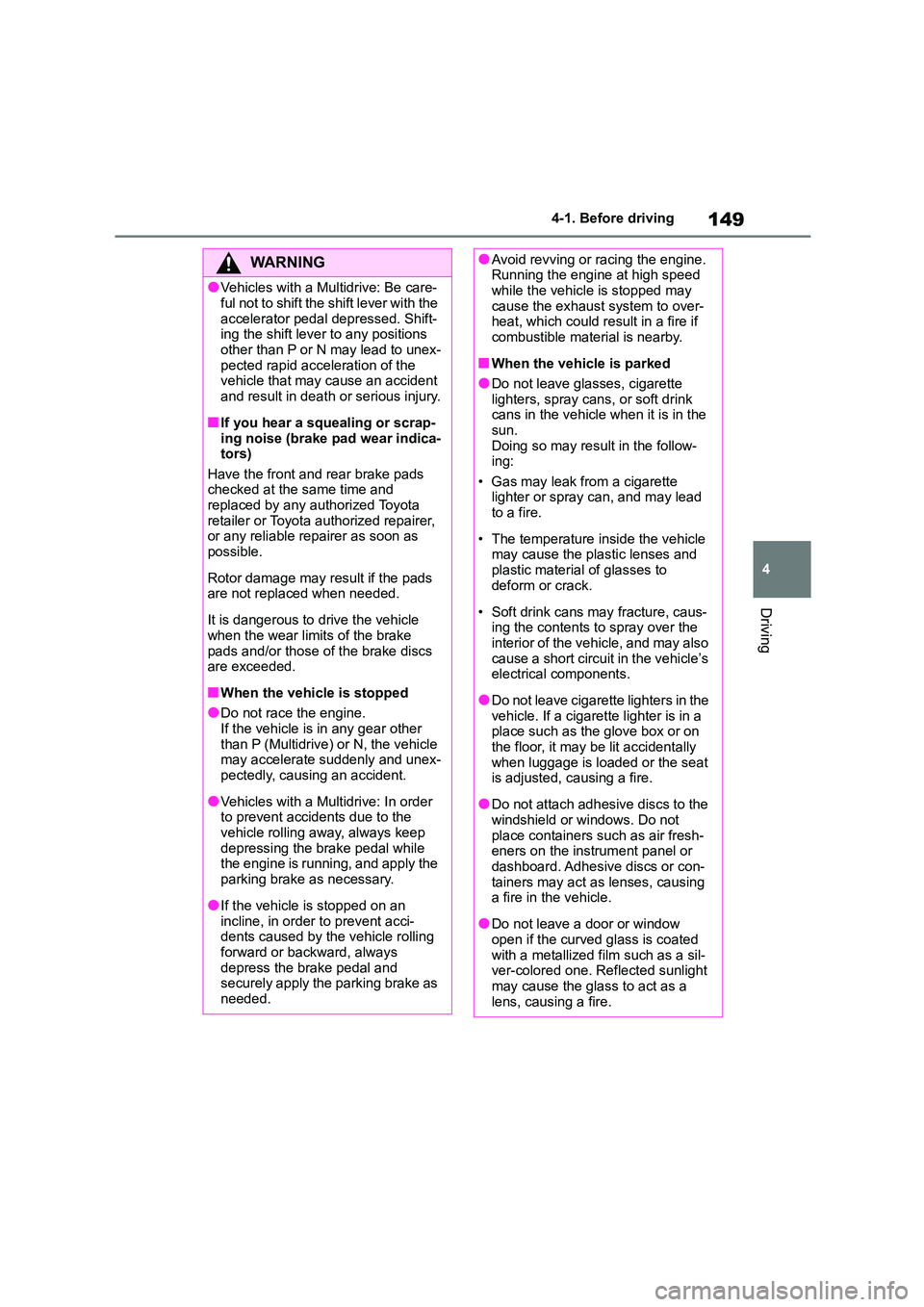
149
4
4-1. Before driving
Driving
WA R N I N G
●Vehicles with a Multidrive: Be care-
ful not to shift the shift lever with the
accelerator pedal depressed. Shift- ing the shift lever to any positions
other than P or N may lead to unex-
pected rapid acceleration of the vehicle that may cause an accident
and result in death or serious injury.
■If you hear a squealing or scrap- ing noise (brake pad wear indica-
tors)
Have the front and rear brake pads checked at the same time and
replaced by any authorized Toyota
retailer or Toyota authorized repairer, or any reliable repairer as soon as
possible.
Rotor damage may result if the pads
are not replaced when needed.
It is dangerous to drive the vehicle
when the wear limits of the brake
pads and/or those of the brake discs are exceeded.
■When the vehicle is stopped
●Do not race the engine.
If the vehicle is in any gear other
than P (Multidrive) or N, the vehicle may accelerate suddenly and unex-
pectedly, causing an accident.
●Vehicles with a Multidrive: In order
to prevent accidents due to the
vehicle rolling away, always keep depressing the brake pedal while
the engine is running, and apply the
parking brake as necessary.
●If the vehicle is stopped on an
incline, in order to prevent acci- dents caused by the vehicle rolling
forward or backward, always
depress the brake pedal and securely apply the parking brake as
needed.
●Avoid revving or racing the engine. Running the engine at high speed
while the vehicle is stopped may
cause the exhaust system to over- heat, which could result in a fire if
combustible material is nearby.
■When the vehicle is parked
●Do not leave glasses, cigarette
lighters, spray cans, or soft drink cans in the vehicle when it is in the
sun.
Doing so may result in the follow- ing:
• Gas may leak from a cigarette
lighter or spray can, and may lead to a fire.
• The temperature inside the vehicle may cause the plastic lenses and
plastic material of glasses to
deform or crack.
• Soft drink cans may fracture, caus-
ing the contents to spray over the interior of the vehicle, and may also
cause a short circuit in the vehicle’s
electrical components.
●Do not leave cigarette lighters in the
vehicle. If a cigarette lighter is in a place such as the glove box or on
the floor, it may be lit accidentally
when luggage is loaded or the seat is adjusted, causing a fire.
●Do not attach adh esive discs to the windshield or windows. Do not
place containers such as air fresh-
eners on the instrument panel or dashboard. Adhesive discs or con-
tainers may act as lenses, causing
a fire in the vehicle.
●Do not leave a door or window
open if the curved glass is coated
with a metallized film such as a sil- ver-colored one. Reflected sunlight
may cause the glass to act as a
lens, causing a fire.
Page 369 of 678
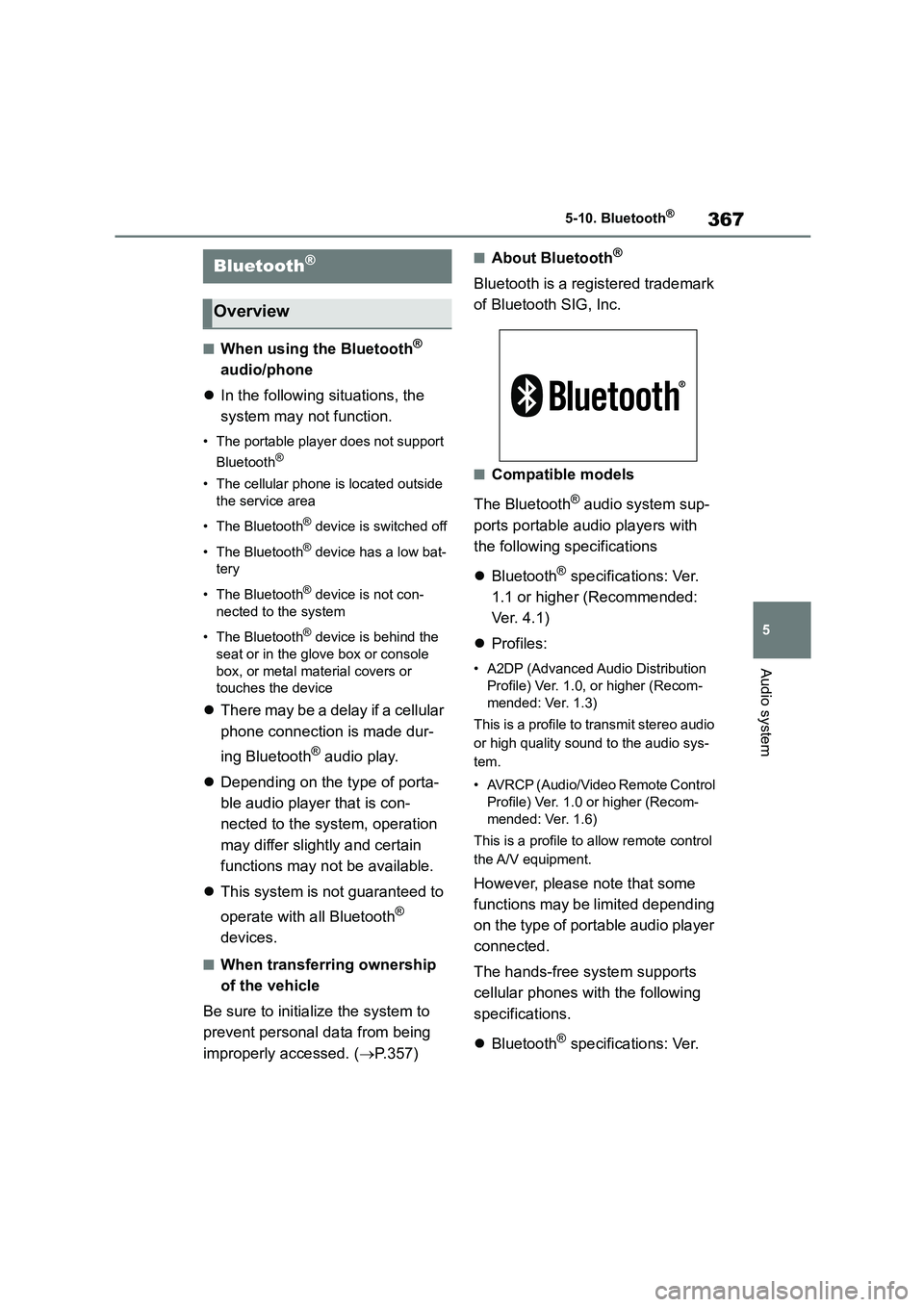
367
5
5-10. Bluetooth®
Audio system
5-10.Bluetooth®
■When using the Bluetooth®
audio/phone
In the following situations, the
system may not function.
• The portable player does not support
Bluetooth®
• The cellular phone is located outside
the service area
• The Bluetooth® device is switched off
• The Bluetooth® device has a low bat-
tery
• The Bluetooth® device is not con-
nected to the system
• The Bluetooth® device is behind the
seat or in the glove box or console
box, or metal material covers or
touches the device
There may be a delay if a cellular
phone connection is made dur-
ing Bluetooth® audio play.
Depending on the type of porta-
ble audio player that is con-
nected to the system, operation
may differ slightly and certain
functions may not be available.
This system is not guaranteed to
operate with all Bluetooth®
devices.
■When transferring ownership
of the vehicle
Be sure to initialize the system to
prevent personal data from being
improperly accessed. ( P.357)
■About Bluetooth®
Bluetooth is a registered trademark
of Bluetooth SIG, Inc.
■Compatible models
The Bluetooth® audio system sup-
ports portable audio players with
the following specifications
Bluetooth® specifications: Ver.
1.1 or higher (Recommended:
Ve r. 4 . 1 )
Profiles:
• A2DP (Advanced Audio Distribution
Profile) Ver. 1.0, or higher (Recom-
mended: Ver. 1.3)
This is a profile to transmit stereo audio
or high quality sound to the audio sys-
tem.
• AVRCP (Audio/Video Remote Control
Profile) Ver. 1.0 or higher (Recom-
mended: Ver. 1.6)
This is a profile to allow remote control
the A/V equipment.
However, please note that some
functions may be limited depending
on the type of portable audio player
connected.
The hands-free system supports
cellular phones with the following
specifications.
Bluetooth® specifications: Ver.
Bluetooth®
Overview
Page 398 of 678
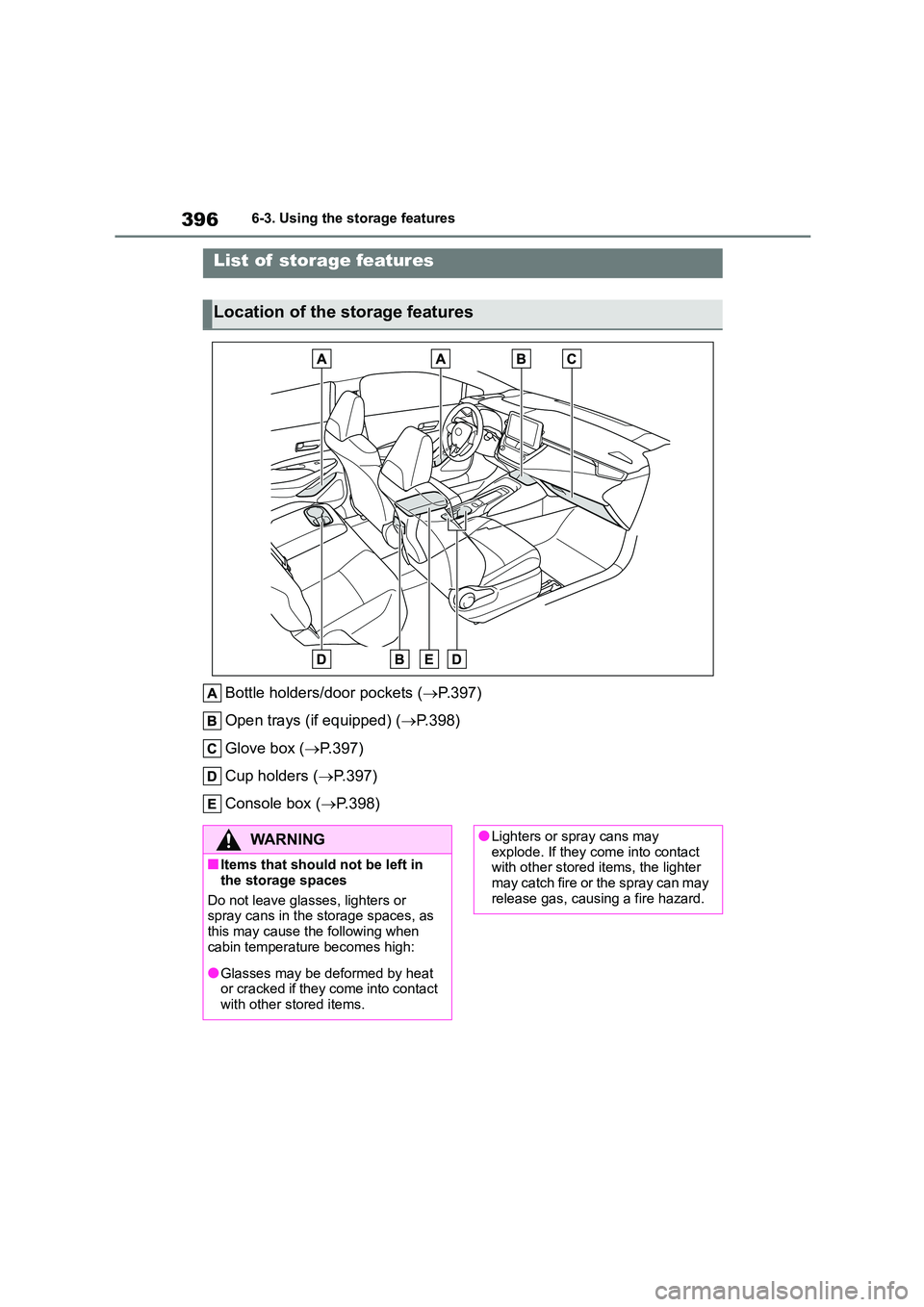
3966-3. Using the storage features
6-3.Using the storage features
Bottle holders/door pockets (P.397)
Open trays (if equipped) ( P.398)
Glove box ( P.397)
Cup holders ( P.397)
Console box ( P.398)
List of storage features
Location of the storage features
WA R N I N G
■Items that should not be left in
the storage spaces
Do not leave glasses, lighters or
spray cans in the storage spaces, as
this may cause the following when cabin temperature becomes high:
●Glasses may be deformed by heat or cracked if they come into contact
with other stored items.
●Lighters or spray cans may
explode. If they come into contact with other stored items, the lighter
may catch fire or the spray can may
release gas, causing a fire hazard.
Page 399 of 678
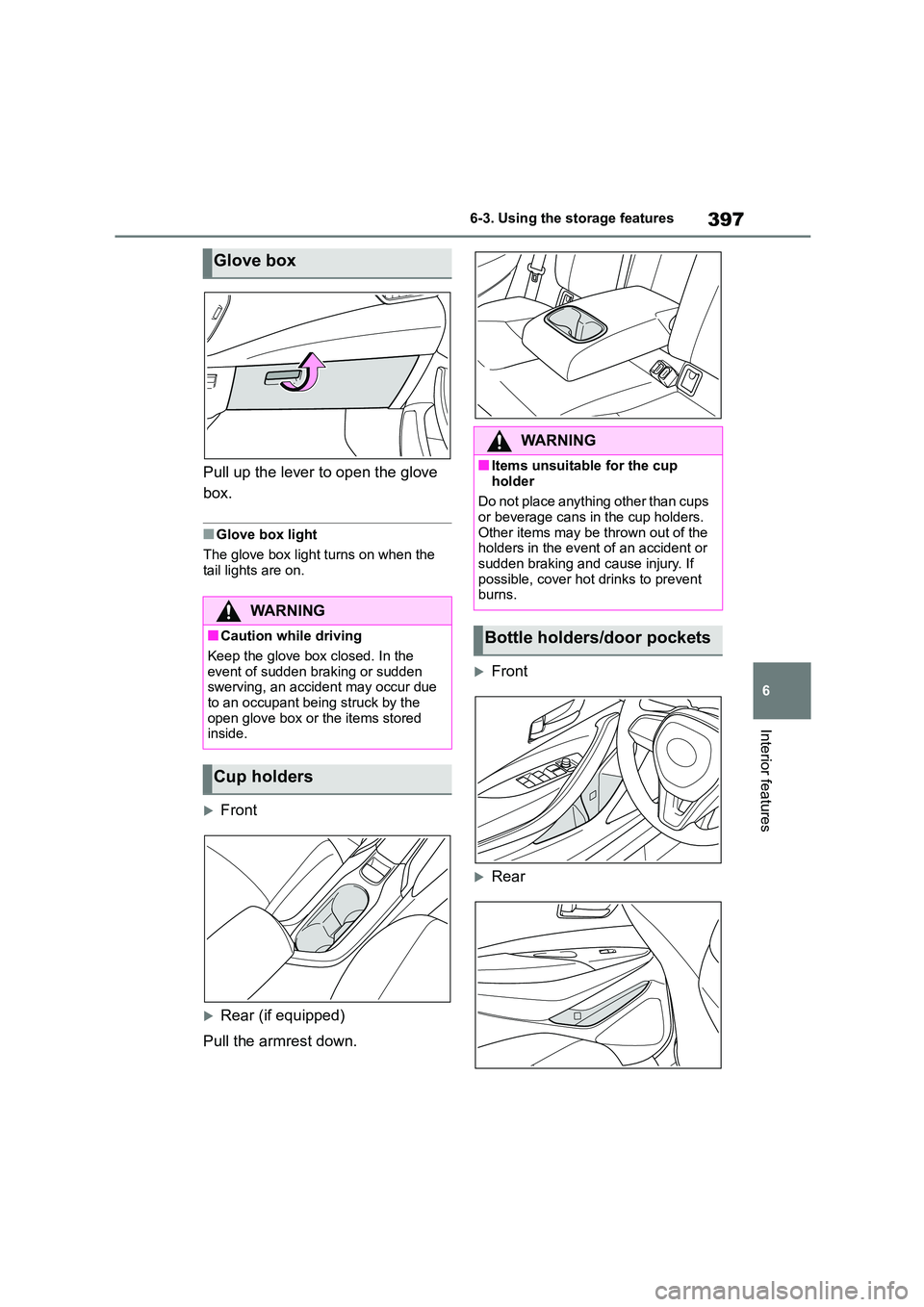
397
6
6-3. Using the storage features
Interior features
Pull up the lever to open the glove
box.
■Glove box light
The glove box light turns on when the
tail lights are on.
Front
Rear (if equipped)
Pull the armrest down.
Front
Rear
Glove box
WA R N I N G
■Caution while driving
Keep the glove box closed. In the
event of sudden braking or sudden
swerving, an accident may occur due to an occupant being struck by the
open glove box or the items stored
inside.
Cup holders
WA R N I N G
■Items unsuitable for the cup
holder
Do not place anything other than cups or beverage cans in the cup holders.
Other items may be thrown out of the
holders in the event of an accident or
sudden braking and cause injury. If possible, cover hot drinks to prevent
burns.
Bottle holders/door pockets
Page 448 of 678
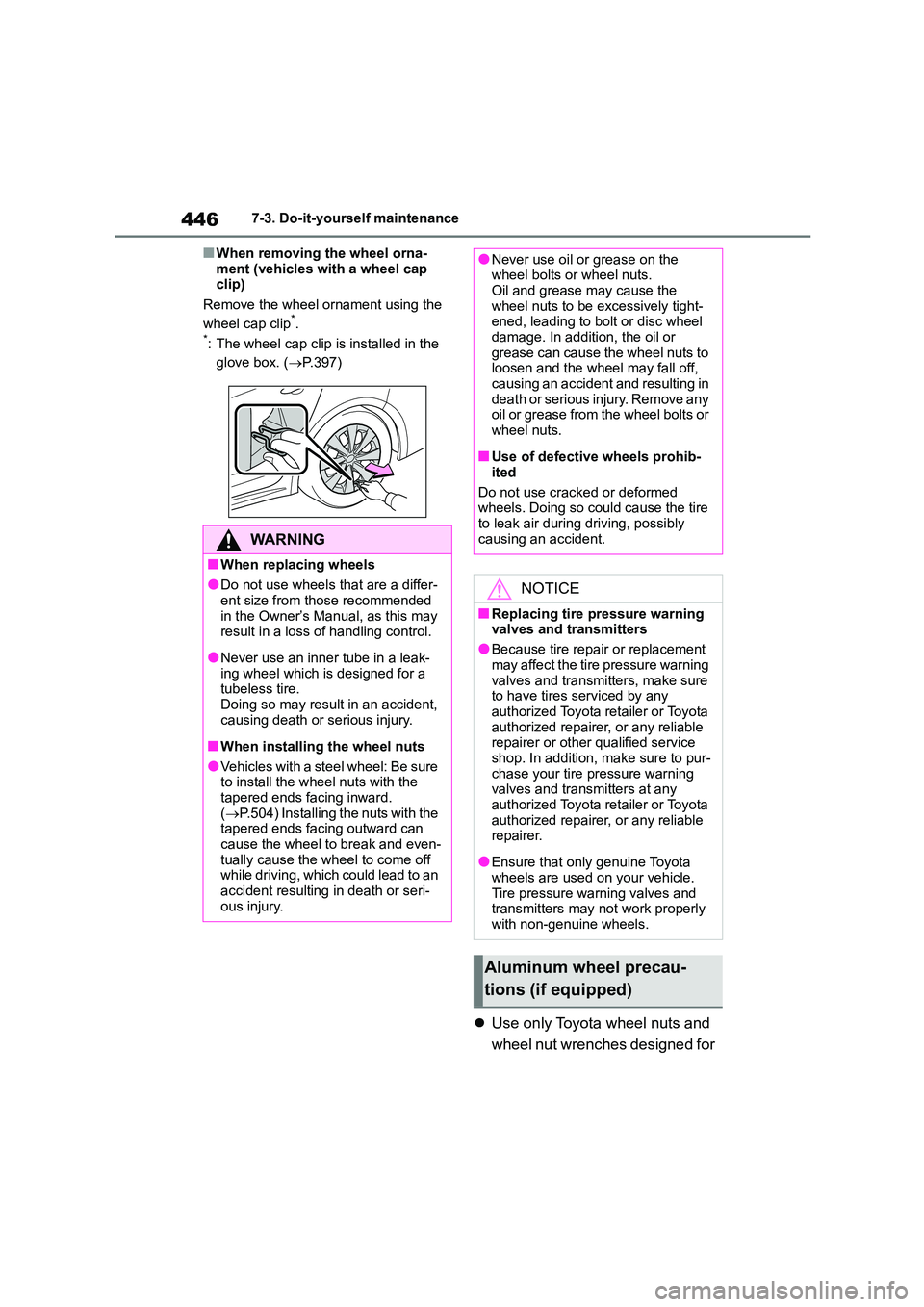
4467-3. Do-it-yourself maintenance
■When removing the wheel orna-
ment (vehicles with a wheel cap clip)
Remove the wheel ornament using the
wheel cap clip*.*: The wheel cap clip is installed in the
glove box. ( P.397)
Use only Toyota wheel nuts and
wheel nut wrenches designed for
WA R N I N G
■When replacing wheels
●Do not use wheels that are a differ-
ent size from those recommended
in the Owner’s Manual, as this may result in a loss of handling control.
●Never use an inner tube in a leak-ing wheel which is designed for a
tubeless tire.
Doing so may result in an accident, causing death or serious injury.
■When installing the wheel nuts
●Vehicles with a steel wheel: Be sure
to install the wheel nuts with the
tapered ends facing inward. ( P.504) Installing the nuts with the
tapered ends facing outward can
cause the wheel to break and even- tually cause the wheel to come off
while driving, which could lead to an
accident resulting in death or seri- ous injury.
●Never use oil or grease on the wheel bolts or wheel nuts.
Oil and grease may cause the
wheel nuts to be excessively tight- ened, leading to bolt or disc wheel
damage. In addition, the oil or
grease can cause the wheel nuts to loosen and the wheel may fall off,
causing an accident and resulting in
death or serious injury. Remove any oil or grease from the wheel bolts or
wheel nuts.
■Use of defective wheels prohib-
ited
Do not use cracked or deformed wheels. Doing so could cause the tire
to leak air during driving, possibly
causing an accident.
NOTICE
■Replacing tire pressure warning valves and transmitters
●Because tire repair or replacement
may affect the tire pressure warning valves and transmitters, make sure
to have tires serviced by any
authorized Toyota retailer or Toyota authorized repairer, or any reliable
repairer or other qualified service
shop. In addition, make sure to pur- chase your tire pressure warning
valves and transmitters at any
authorized Toyota retailer or Toyota authorized repairer, or any reliable
repairer.
●Ensure that only genuine Toyota
wheels are used on your vehicle.
Tire pressure warning valves and transmitters may not work properly
with non-genuine wheels.
Aluminum wheel precau-
tions (if equipped)
Page 449 of 678
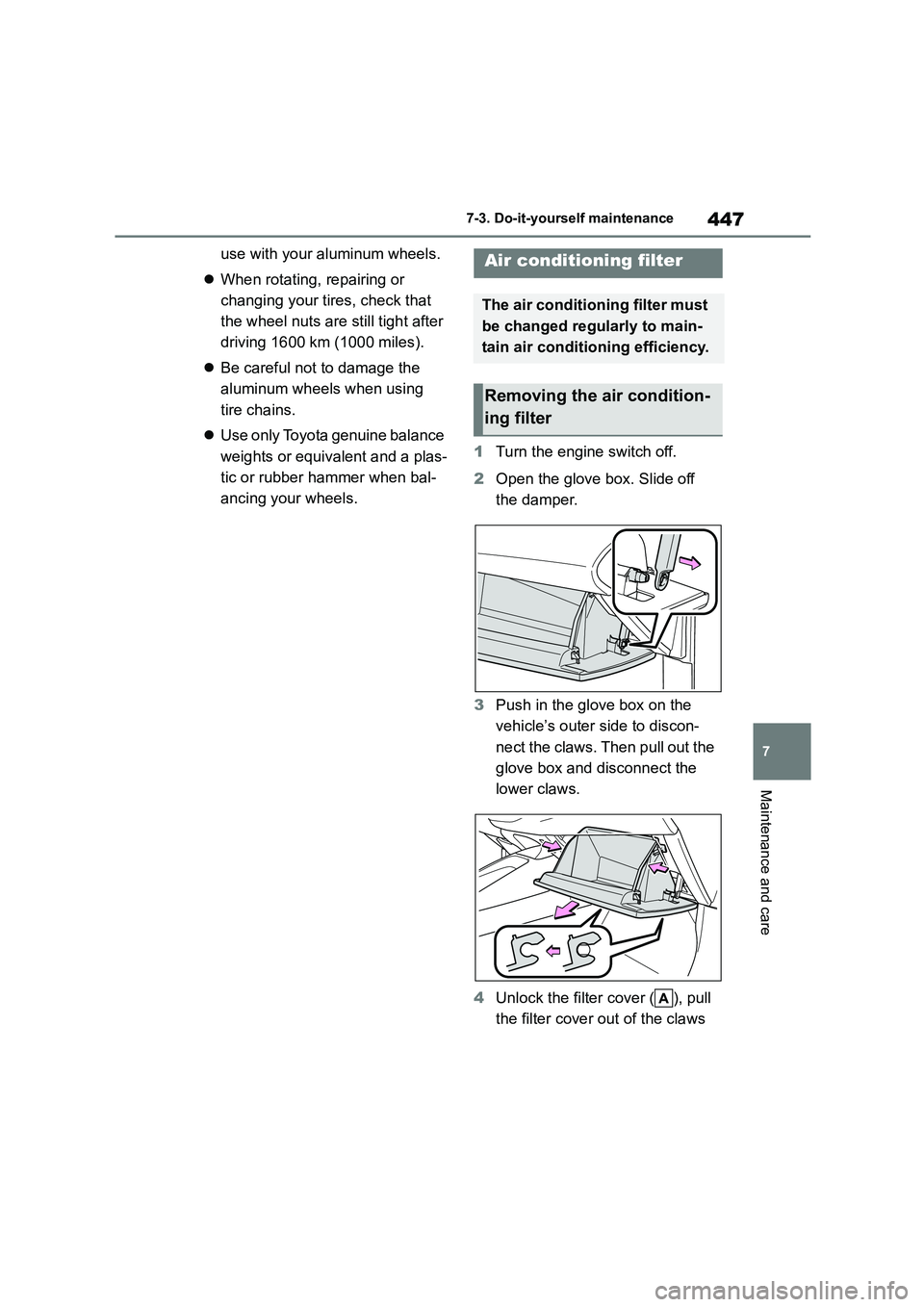
447
7
7-3. Do-it-yourself maintenance
Maintenance and care
use with your aluminum wheels.
When rotating, repairing or
changing your tires, check that
the wheel nuts ar e still tight after
driving 1600 km (1000 miles).
Be careful not to damage the
aluminum wheels when using
tire chains.
Use only Toyota genuine balance
weights or equivalent and a plas-
tic or rubber hammer when bal-
ancing your wheels.
1 Turn the engine switch off.
2 Open the glove box. Slide off
the damper.
3 Push in the glove box on the
vehicle’s outer side to discon-
nect the claws. Then pull out the
glove box and disconnect the
lower claws.
4 Unlock the filter cover ( ), pull
the filter cover out of the claws
Air conditioning filter
The air conditioning filter must
be changed regularly to main-
tain air conditioning efficiency.
Removing the air condition-
ing filter
Page 558 of 678
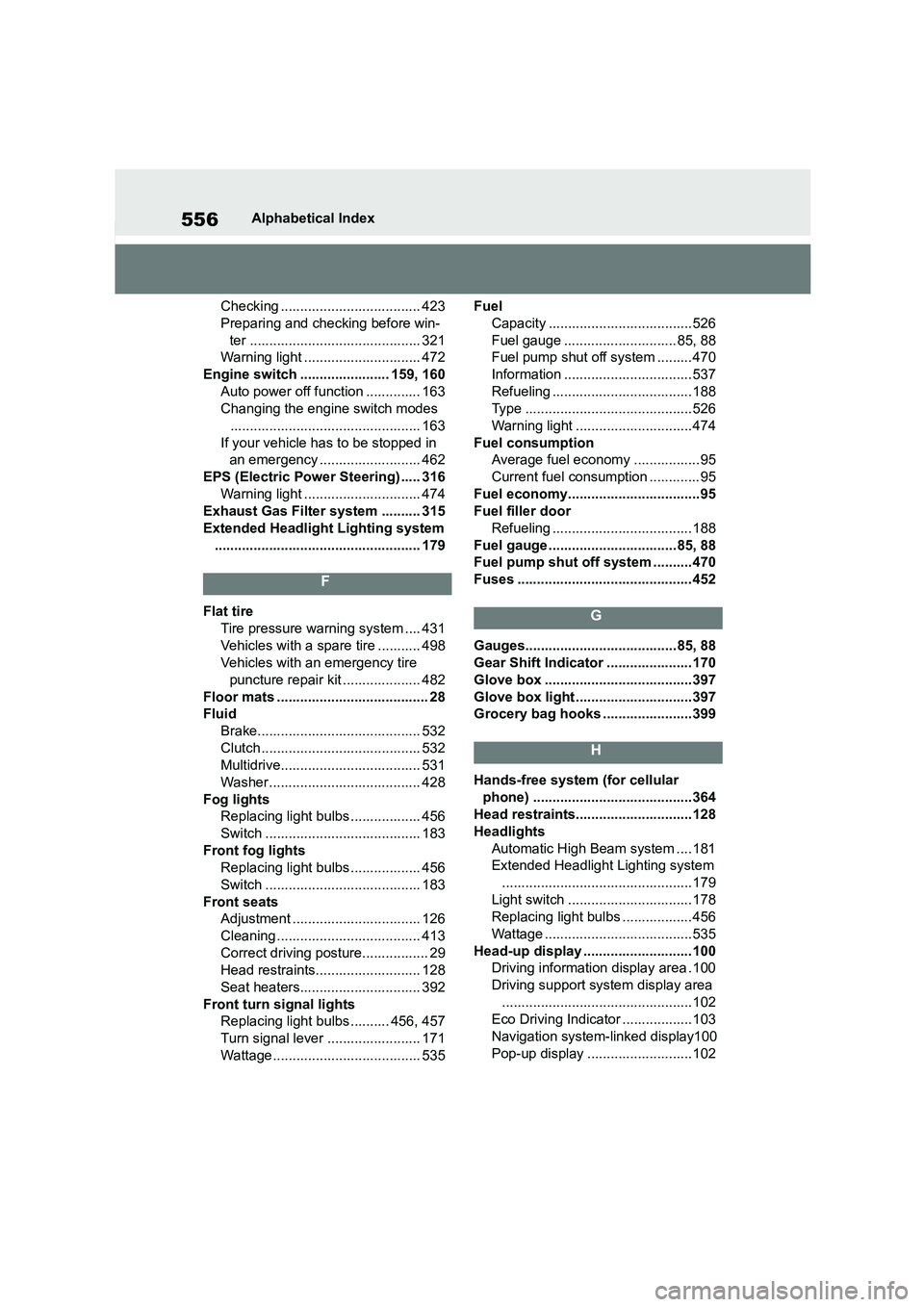
556Alphabetical Index
Checking .................................... 423
Preparing and checking before win-
ter ............................................ 321
Warning light .............................. 472
Engine switch ....................... 159, 160
Auto power off function .............. 163
Changing the engine switch modes
................................................. 163
If your vehicle has to be stopped in
an emergency .......................... 462
EPS (Electric Power Steering) ..... 316
Warning light .............................. 474
Exhaust Gas Filter system .......... 315
Extended Headlight Lighting system
..................................................... 179
F
Flat tire
Tire pressure wa rning system .... 431
Vehicles with a spare tire ........... 498
Vehicles with an emergency tire
puncture repair kit .................... 482
Floor mats ....................................... 28
Fluid
Brake.......................................... 532
Clutch ......................................... 532
Multidrive.................................... 531
Washer....................................... 428
Fog lights
Replacing light bulbs .................. 456
Switch ........................................ 183
Front fog lights
Replacing light bulbs .................. 456
Switch ........................................ 183
Front seats
Adjustment ................................. 126
Cleaning ..................................... 413
Correct driving posture................. 29
Head restraints........................... 128
Seat heaters............................... 392
Front turn signal lights
Replacing light bulbs .......... 456, 457
Turn signal lever ........................ 171
Wattage...................................... 535
Fuel
Capacity .....................................526
Fuel gauge ............................. 85, 88
Fuel pump shut off system .........470
Information ................................. 537
Refueling .................................... 188
Type ...........................................526
Warning light ..............................474
Fuel consumption
Average fuel economy ................. 95
Current fuel consumption ............. 95
Fuel economy.................................. 95
Fuel filler door
Refueling .................................... 188
Fuel gauge .................................85, 88
Fuel pump shut off system ..........470
Fuses ............................................. 452
G
Gauges.......................................85, 88
Gear Shift Indicator ...................... 170
Glove box ......................................397
Glove box light ..............................397
Grocery bag hooks .......................399
H
Hands-free system (for cellular
phone) .........................................364
Head restraints..............................128
Headlights
Automatic High Beam system ....181
Extended Headlight Lighting system
.................................................179
Light switch ................................178
Replacing light bulbs ..................456
Wattage ......................................535
Head-up display ............................ 100
Driving information display area . 100
Driving support system display area
.................................................102
Eco Driving Indicator ..................103
Navigation system-linked display100
Pop-up display ...........................102